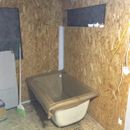Waterproofing a Shower With OSB Walls
Hi,
I’m about half-way through building our tiny house on wheels, and am trying to decide how to waterproof our shower/tub walls. The back wall and one side are OSB, the inside skin of the SIPS we used to construct our walls. The second side is currently bare wood framing, our only framed interior wall. The tub measures 48″ L x 32 in wide, so standard 1-piece plastic shower wall kits don’t fit (plus they are ugly!). The photo I have is older, and doesn’t show the framed wall. We have an acrylic tub, so no need to waterproof the floor, but I’m trying to figure out the best way to keep the OSB dry. I’m planning to use corrugated metal as the inside shower wall surface, since tile walls are heavy, stiff, and likely to crack with the amount of vibrations that a trailer will make on the road. I want a solid waterproof layer behind that metal. I’ve looked at liquid-applied waterproofing like Red Guard or Proflex Hydraseal; membranes like Shluter Kerdi, and waterproof xps backer board like kerdi board and wedi board, which are all designed for hanging tile. The option I like the most currently is shingling 12-in wide butyl window flashing (Grace Vycor Pro) to the OSB to seal everything completely, including any fastener penetrations from attaching the corrugated metal. I’ll have to use a hefty amount of silicone caulk at the wall-ceiling transition, but should be able to flash over the edge of the tub. The ceiling in the bathroom will be 2×6 T$G eastern red cedar- the bottom of our loft floor. Our loft beams (4×4 doug fir) will be stained on all 4 sides with Rubio monocoat. I’m installing a bathroom exhaust fan that is selectable from 50-100 cfm with a humidity-controlled auto switch to keep the humidity at 30% or less. I’m happy to layer the walls a bit in order to make a good waterproof layer, but not sure what would be best. My priorities are 1) waterproof (no rotting OSB), 2) low cost and 3) green! Code is not a concern. Thank you!
GBA Detail Library
A collection of one thousand construction details organized by climate and house part











Replies
I have never done anything like this, but looking how well these hold up on the outside of the house, the peel and stick should work well, just make sure to lap the bottom over the lip on the tub. Do a sniff test on it before committing, some of the peel and sticks are fine outdoors but can have a pretty strong odor when installed indoors.
Having a 4 foot tub means the long wall can be of any sheet good you can imagine. I cannot imagine using something non continuous when this is the case.
This is a good point, however, I will be using fasteners from the metal to the OSB, so any continuous sheet will be penetrated multiple times. ALL of the waterproof membranes and backer boards require additional sealing for fastener penetrations, but butyl is self-sealing. I wish it came in wider widths, but the widest I can find is 12 in.
I would consider a multi-piece shower/tub stall. Skip the Galv metal panels!
You won't need expensive peel and stick membrane either.
Standard plumbing fixtures equals less homemade and a nicer finish. You ll be happier.
I believe I saw an article some time back about basically using a rain screen inside the shower. If you were to first use a fluid applied product, like Redguard, and then install horizontal furring strips with a slight bevel on the top edge, you could then attach your corrugated metal to that, leaving an air gap behind that should easily drain down to the lip of the tub, leaving the OSB protected.
The bonus to this method is that it's more easily repairable / replaceable than attaching to the inner skin of the SIP, and ought to be more air-tight with a reduced number of penetrations. Should you choose to go a different route in the future, simply unscrew the corrugated metal from the furring strips.
You get the ease of the fluid applied membrane, low cost of the furring strips, reduced penetrations, and increased repairability.
Can't say the idea of a corrugated metal shower seems like a good one but I would definitely be gluing the metal, not screwing. You'd just be rolling the dice on not having a fastener penetration leak and with the OSB being very difficult to repair/replace with a SIP, no way I'd take that chance. Definitely waterproof behind the corrugated metal with Redguard or similar